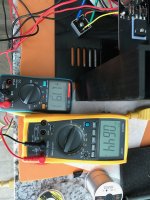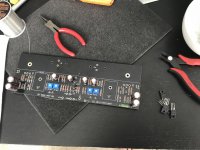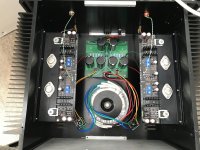Hi Bob,
Very glad your amp is working again. I wonder what might have damaged the 2sj28.
Dennis
Very glad your amp is working again. I wonder what might have damaged the 2sj28.
Dennis
To ZM - but I'm older than your Papa 🙂
To Dennis - good question !!! - only one seemed to be bad but I replaced the pair.
To Dennis - good question !!! - only one seemed to be bad but I replaced the pair.
I’m trying to Bias the front end to 1.5v J313 is good but the k2013 on P4 will only go to .9 with T18 near 0.
At 1.8V it will sit at 1.1v.
I’m measuring across the 47.5r resistors, and don’t have the Vfets in yet.
Any ideas?
At 1.8V it will sit at 1.1v.
I’m measuring across the 47.5r resistors, and don’t have the Vfets in yet.
Any ideas?
I’m trying to Bias the front end to 1.5v J313 is good but the k2013 on P4 will only go to .9 with T18 near 0.
At 1.8V it will sit at 1.1v.
I’m measuring across the 47.5r resistors, and don’t have the Vfets in yet.
Any ideas?
Biasing the front end is a pain. After heating up, your 0.9V will go up to about 1.08, which is however still below the desirable voltage. It is either to change p3-p4 to 1kOhm or (in my case) r34-r35 changed to 333 ohm and still I am slightly below 1.2V.
More pity is that I use "matched" pairs of LSK/LSJ from diyaudio store...
Unfortunately even when you are using matched jfets, you can run into
this issue if their idss is on the low side of the BL/B grade range. 🙁
damuffin: Assuming the R5/R6 values are correct at 47.5R, have you tried
backing off a bit the bias on the J313 and then see if you can increase the
bias on the K2013 while maintaining reasonably low offset at T18?
this issue if their idss is on the low side of the BL/B grade range. 🙁
damuffin: Assuming the R5/R6 values are correct at 47.5R, have you tried
backing off a bit the bias on the J313 and then see if you can increase the
bias on the K2013 while maintaining reasonably low offset at T18?
Last edited:
Thanks for the responses, The Jfet devices were marked as 7.5 and 7.59. I have another set marked 9.2ma.
The recommendation “JFETs are selected for Idss to within a milliamp or so at 8ma”
After further testing it looks like the other channel is acting the same way with a .7v stagger.
What would be the lowest and highest practical value 1.2v and 1.8v with the offset near 0?
The trim pots are not maxed out so will changing resistance values actual narrow the gap?
The recommendation “JFETs are selected for Idss to within a milliamp or so at 8ma”
After further testing it looks like the other channel is acting the same way with a .7v stagger.
What would be the lowest and highest practical value 1.2v and 1.8v with the offset near 0?
The trim pots are not maxed out so will changing resistance values actual narrow the gap?
So after a few hours of loosing hair, I’ve come to realize that my volt meters measure .5v differently...........
Mind Blown!
Mind Blown!
Phew! Glad you figured it out. 🙂
I read again what your wrote afte looking at the schematics and
realized your measurements were inconsistent, since the diff in voltages
across R5 and R6 would imply a current going through R31, giving rise to an
offset at T18.
Hope the rest of your construction goes smoothly.
Dennis
I read again what your wrote afte looking at the schematics and
realized your measurements were inconsistent, since the diff in voltages
across R5 and R6 would imply a current going through R31, giving rise to an
offset at T18.
Hope the rest of your construction goes smoothly.
Dennis
Pass DIY Addict
Joined 2000
Paid Member
An aging battery in one DMM will also produce screwy results. Glad to hear it turned out to be something simple. A vfet2 amp is probably my next build. I think the only parts missing are some PSU caps and a chassis. Little by little... I'm excited to connect it to my in-progress B1-Korg preamp.
So after a few hours of loosing hair, I’ve come to realize that my volt meters measure .5v differently...........
Mind Blown!
So how did you decide which one to use as the benchmark?
I'm almost ready to start my VFET kit and I just bought my 3rd meter. It's good to know that I should check them against each other!
Success
The older VICHY has been used in many amps. It was the new NKTECH meter that was out. I clued in when measuring the supply voltages. They showed up as 32V and the VICHY was 28V.
So after 4 days of drilling and soldering we’ve got music.
I’d like to thank everyone involved in creating this amp, you can tell Papa had at least one sleepless night playing with this circuit.
And the crew at DiyAudio store.
So how did you decide which one to use as the benchmark?
The older VICHY has been used in many amps. It was the new NKTECH meter that was out. I clued in when measuring the supply voltages. They showed up as 32V and the VICHY was 28V.
So after 4 days of drilling and soldering we’ve got music.
I’d like to thank everyone involved in creating this amp, you can tell Papa had at least one sleepless night playing with this circuit.

And the crew at DiyAudio store.

Attachments
@damuffin
Looks very nice and tidy excellent build. What is the PSU you are using looks compact and almost like the FW commercial one. Where did you get this PSU?
thanks
Looks very nice and tidy excellent build. What is the PSU you are using looks compact and almost like the FW commercial one. Where did you get this PSU?
thanks
Ok, now its several days they both works fine. And yes, they are REALLY hot, so after an hour it is not possible to hold the hand on front panel (which is the heatsink). Output devices measured 63C max with top lids closed, no ventilation. I believe 105C caps will last much longer then couple of years. What to say more: sound is ... special, now I can not say I like it or not. The only word spinning in my head regarding the sound is: clear, clarity, clarification, clearness. Timbres are somewhat subtile, to my perception. Low-end highs are almost absent, alas voice and mid-range are emphasised. Bass is deep, but not that solid, like in good powerful mosfet amp... maybe the source is not that good or they need more time to burn-in. Nevertheless it was a good exciting adventure.
Now the amps are fully burnt-in, so I dare to say couple more words about the sound and other findings.
1. Sound is "sweet" but not "tubey".
2. No mess even on complicated high-dynamic tracks. Clarity.
3. Real "stereo", not just simply two hearable sources of left and right channel, but a complete pictured soundstage where left and right are not distinguishable from each other.
4. Very demanding to the source quality. Contrary to my original sony ta-n7b, which is pretty omnivorous. Put it on some poor dac or preamp and your ears got screwed. I am using benchmark dac1 hdr.
5. Bass is just tremendous. Speakers are victor sx-v7. Just tremendous.
6. Very sensible to interconnect cables, difference in clearly distinguishable.
7. Still seems the actual gain is lower then 36dB as per the Nelson's guide.
Now the amps are fully burnt-in, so I dare to say couple more words about the sound and other findings.
1. Sound is "sweet" but not "tubey".
2. No mess even on complicated high-dynamic tracks. Clarity.
3. Real "stereo", not just simply two hearable sources of left and right channel, but a complete pictured soundstage where left and right are not distinguishable from each other.
4. Very demanding to the source quality. Contrary to my original sony ta-n7b, which is pretty omnivorous. Put it on some poor dac or preamp and your ears got screwed. I am using benchmark dac1 hdr.
5. Bass is just tremendous. Speakers are victor sx-v7. Just tremendous.
6. Very sensible to interconnect cables, difference in clearly distinguishable.
7. Still seems the actual gain is lower then 36dB as per the Nelson's guide.
I agree with your impressions. Switching from my CD player to my turntable and Audio Research PH5 phono stage is a huge improvement. CD’s sound great, but what I hear from the record grooves is phenomenal. Basically, this just shows that the Pass DIY Sony VFET amp is only as good as what’s connected to it.
Listening to Brian Eno’s “Another Green World” vinyl remaster, I hear this album in a whole different light with incredible separation, tonality, and depth of Eno’s sophisticated production.
Finally building the VFET CSX1 PCBs
Yes I know it's late to the VFET build, but finally got around to building the CSX1 boards I bought some time ago. I do have the VFETs and most of the parts appear self-explanatory. I am waiting for the grade B JFETs, LSJ74/LSK170 set.
Question, any kind of parts list for this kit? Possible part no's for the pots, and caps would be nice, rather than trial & error...The schematic and PCB labling do not quite agree on voltages and parts, ref designators are unlabeled, has anyone found other discrepancies? Once I have the parts, I'll document the build. I have alu pieces for the heat sink. I searched for a build on the CSX1-PCB...
Yes I know it's late to the VFET build, but finally got around to building the CSX1 boards I bought some time ago. I do have the VFETs and most of the parts appear self-explanatory. I am waiting for the grade B JFETs, LSJ74/LSK170 set.
Question, any kind of parts list for this kit? Possible part no's for the pots, and caps would be nice, rather than trial & error...The schematic and PCB labling do not quite agree on voltages and parts, ref designators are unlabeled, has anyone found other discrepancies? Once I have the parts, I'll document the build. I have alu pieces for the heat sink. I searched for a build on the CSX1-PCB...
- Home
- Amplifiers
- Pass Labs
- Sony vFET Amplifier Part 2





